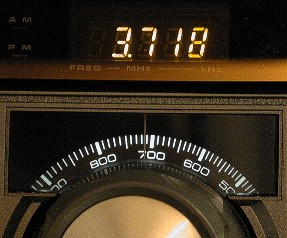
Equipment
These are my major devices.
Links inside this page (hops):
FT-897 | FT-225RD | MT 3000A | R-5000 | FRG 7700 | TH F7E | MA 440 | FT-470 | FT-209 | XR 2000 | MT-4000L | Sporty
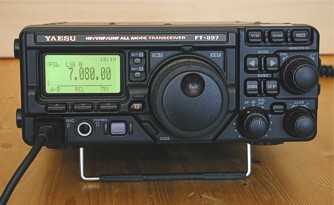
FT-897 (Yaesu)
Transceiver, shortwave + 2m + 70cm. Got it in spring 2005 from from Rolf, DL4JK. My first short wave transceiver ever. Nice set for outdoor operation. Power 100W on short wave, 50W on 2m and 20W on 70cm. Weight 4kg. Like with all these compact-class transceivers, it needs skillful "menu surfing" in order to "just" change some setting. The FT-897 can be controlled via PC, and also the 200 memories can be occupied this way. I cannot say much about its receiving qualities as I have no comparison nor other short wave transceivers. The set worked very well for me during my stay in Sweden and on Mallorca island.
To top of page
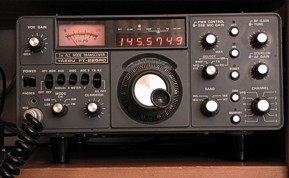
FT-225RD (Yaesu)
I got this all-mode 2m transceiver in 1979 and had many QSOs with it. My antenna used to be a Veron beam. The most distant contact was SV8. The transceiver is still working, however, the VFO sometimes starts running (about 5kHz in the first hour). Contrary to its competitor, the Icom IC 211 E, the Yaesu FT 225 has a real frequency display (not counting just holes as the IC 211 did). The output power is 25 W. Most of the units are assembled on plug-in cards. Using a self made extension card, adjustments to the trimming parts were easy. I once lend my extension card and never received it back, otherwise I would have already applied a complete adjustment to the set. Now and then I have it standby on 145.575 (Oberhausen local channel).
To top of page
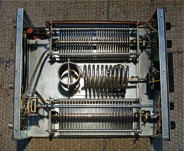
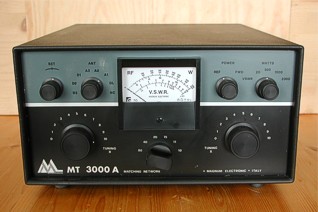
MT 3000A (Magnum Electronic)
Matching device. Acquired in summer 2006 from Rolf, DL4JK. No manual. I guess it was produced somewhere at the end of the 70ies. Three antennas can be connected, either direct (feed through) or via the matching network. Maximum transmitting power 2000W (according to front labelling).
To top of page
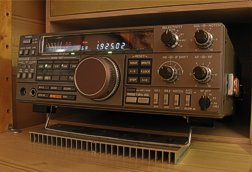
R-5000 (Kenwood)
Short wave receiver with VHF module. Receiving range: 100 khz - 30 Mhz, 108 Mhz - 174 Mhz. Voice module built in. Acquired in September 2003. 100 memories. Nice set, but it warms up very much. The built-in speaker is to my oppinion of low quality. In comparison to the FRG 7700 (with its warm sound), listening with the built-in speaker is of little fun. The set is stable in frequency. The numeric keys are not de-bounced, entering frequencies via these keys is a gamble. To my opinion the search mode is not of great use. Searching (scanning) is slow to the first, and to the second the search often stops one channel behind. For scanning a real scanner should be used. In low dimmed illumination, the S-meter illumination is too low. I have put a bridge, now the S-meter is bright even in low dimming (which is my default). My R-5000 cannot be controlled via PC (as most of them cannot), but there seems to exist a way to retrofit the serial connection parts (with some major efforts). I have not yet put additional filters, a YK-88SN-1 is still waiting in the drawer.
To top of page
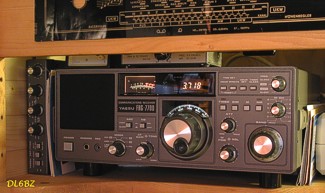
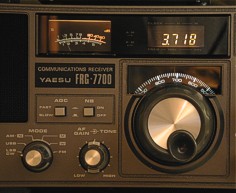
FRG 7700 (Yaesu)
My favorite short wave receiver — owing to nostalgia. With its "grandpa" FRG-7 I had my first short wave listening experiences at the end of the 70ies. Receiving range from 100 kHz to 30Mhz in 1Mhz ranges. To me the FRG 7700 is just beautiful, the built-in speaker has a warm and substantial sound. Certainly the set cannot be called modern - at least regarding nowadays bits and pieces. Also the receiver is not very stable in the first 15 minutes. I own two of them, one with memory unit. When am sitting soldering I have it usually tuned to the 80m band. In FM the modulation is quite dull (muffled), however, by changing one capacitor this can be helped. The combination of analog scale and digital display, as with the FT225, still suits me very well. This is intuitive and literally allows "turning over the band".
To top of page
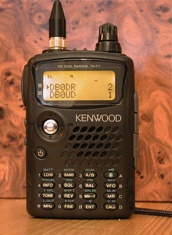
TH F7E (Kenwood)
Dual band transceiver 2m / 70cm with broad band receiver (100kHz - 1300 Mhz) included. Acquired in July 2004. No built-in diplexer, therefore no receiption in band A while sending in band B. Compact set, but they way I see it, it is too small. It has 400 memories which can be controlled via PC. This worked for me only one time, after several tests I conclude that the interface inside the radio is defect. Sometimes I hear station at frequencies where they for sure do not belong, like service radio stations in the air band.
To top of page
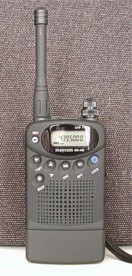
MA 440 (Maycom)
70cm hand held. Acquired in July 2003, returned in June 2004.
Lies good in the hand (Is this good English?). No too tiny, not too big and has some kind of non-skid surface. Pleasant PTT key with noticeable click. Unfortunately my radio turned out to be defect (as well as the replacement radio I got). The frequency generation for TX seemed to be defective. The transmitting frequency walked off to somewhere between 457 and 459 Mhz (according to frequency counter). I was already wondering why some of my calls were not responded. Sometimes I also was told to have a bad modulation. I finally changed it into the TH F7E.
To top of page
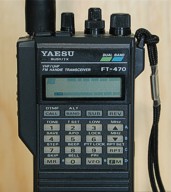 FT 470 (Yaesu)
FT 470 (Yaesu)
True duoband handheld (2m / 70cm) with built-in diplexer. While transmitting on band A receiving is possible on band B. The PTT button needs some pressure and does not respond with a noticeable click. Handling the knobs on top involves fiddling. I own this set since beginning of the 90ies. The accu packs are defect meanwhile, so I removed the cells and fitted in an external power supply connector. For many years the FT-470 runs "stationary" on direct channels.
To top of page
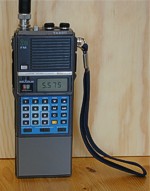 FT 209R (Yaesu)
FT 209R (Yaesu)
My very first hand held, aqcuired in 1986 from DL2BBT. 2m - band device with 3W power. Quite bulky compared to modern hand helds. The accu packs are defect meanwhile, but I still have a battery case. The FT209R uses an internal back-up battery which is discharged now (after more than 20 years). After switching off the device all settings and memories are gone.
To top of page
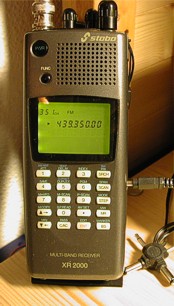
XR 2000 (Stabo)
Fast scanner with 1000 memories. Receiving range 532 kHz - 2 Ghz. Acquired in September 2004. To a pity, the scanner cannot be connected to a PC. Thus all memories have to be set by hand. Each memory can be character labeled. No dual receiption, that is, no listening to both repeater input and output at the same time. Display very well readable. Stable in frequency, also in single side band modes. I have been listening to short wave QSOs now and then. A few meters of antenna wire are sufficient.
To top of page

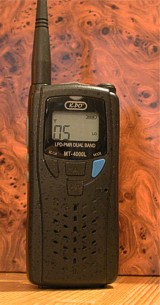
MT-4000L (K-PO)
LPD / PMR device. Can be extended to 99 LPD channels and 10 PMR channels. Power modification possible. Fixed antenna. The case stroke me first as "cheap qualit7y", but it is very robust indeed. The device dropped several times, the display now has some cracks. The rubber button including the pin is lost. I have to switch the radio on/off using a toothpick or similar. Since 3 years I am using the device daily. By now the radio is no more steady - a small breeze and it falls over. Unfortunately the MT-4000 is not produced any more. The follow up radio is smaller (a pity) and is using only three batteries instead of four. Lasting time with 4 x 2300 mA accus (mignon) is about 3 days.
The battery case is not very intuitive. In hurry I sometimes tend to insert the accus the wrong way, in which case the connector springs get warm and melt into the plastic case. Nevertheless, the device is still alive and serving me well.
To top of page
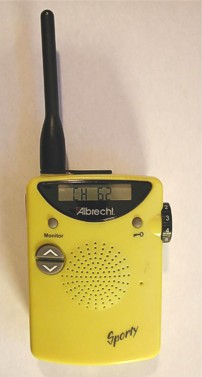 Sporty (Albrecht)
Sporty (Albrecht)
My first LPD device. Acquired in 1998. Removable antenna (SMA). Power supply by two mignon cells. No signal strength indicator, but a true ON/OFF wheel switch.